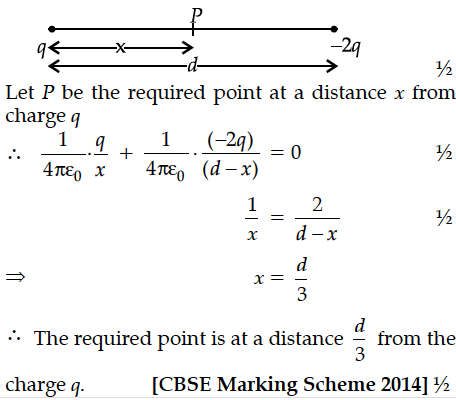Two point charges q and –2q are kept d distance apart. Find the location of the point relative to charge q at which potential due to this system of charges is zero.

Why are electric field lines perpendicular at a point on an equipotential surface of a conductor ?
A point charge +Q is placed at point O as shown in the figure. Is the potential difference – positive, negative or zero ?
Electric potential at a distance r from the point charge is proportional to
1. \(r^2\)
2. r-1
3. r0
4. r+1
Draw a plot showing the variation of (i) electric field (E) and (ii) electric potential (V) with distance r due to a point charge Q.
Obtain the expression for the potential due to an electric dipole of dipole moment p at a point ‘d’ on the axial line.
For any charge configuration, equipotential surface through a point is normal to the electric field. Justify.
Two point charges q and –2q are kept d distance apart. Find the location of the point relative to charge q at which potential due to this system of charges is zero.
Show that the current leads the voltage in phase by in an ac circuit containing an ideal capacitor.
Two charges q and –3q are placed on x-axis separated by distance d. Where a third charge 2q should be placed such that it will not experience any force ?
A small metallic sphere carrying charge +Q is located at the centre of a spherical cavity in a large uncharged metallic spherical shell. Write the charges on the inner and outer surfaces of the shell. Write the expression for the electric field at the point P1.
Find the expression for electric field intensity in an axial position due to electric dipole.
Distinguish between emf (E) and terminal voltage (V) of a cell having internal resistance r. Draw a plot showing the variation of terminal voltage (V) Vs. the current (I) drawn from the cell. Using this plot, how does one determine the internal resistance of the cell ?
Two cells of E.M.F. 10 V and 2 V and internal resistances 10 Ω and 5 Ω respectively, are connected in parallel as shown. Find the effective voltage across R.
